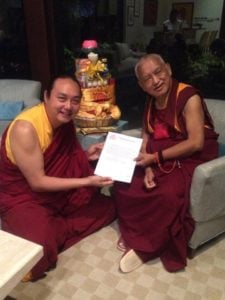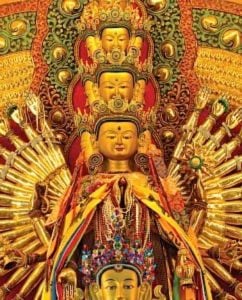Video: “Experience Buddhism” with Singha Namdrol Rinpoche “Buddhism emphasizes, and lays its very foundations on, equanimity.”

Singha Namdrol Rinpoche’s charm is his down-to-earth style of teaching — very evident in the short video Experience Buddhism, below. Although short, the video contains profound insights:
“Our practice is not so much about faith. It’s not so much about prayer…The purpose of practice is to bring out the divinity in us.”
Singha Namdrol Rinpoche is popular, in part, because he is an engaging teacher in both English and Mandarin Chinese. Recognized as a Tulku, Namdrol Rinpoche studied with teachers from Theravada, Mahayana and Tibetan Buddhist traditions. He was a lay Yogi at Kopan Monastery in Nepal for many years. Today, he is the spiritual director at Thekchen Choling temple in Singapore.
For more video teachings from Rinpoche, visit the Thekchen Choling YouTube Channel>>
Transcript of Video

“Buddhism emphasizes and lays it very foundations on equanimity. There is no difference between god and human and animal, rich person, poor person — everybody is fundamentally the same. That is the core teaching of Buddhism.”

More articles by this author

Guru Rinpoche answers Lady Tsogyal: Should we practice one or many yidams? Is the master or the Yidam more important? Why is it important to practice the yidam deity?

Female Enlightened Manifestations and Female Teachers and Lamas — Wisdom in Action; Reader Poll and Interview with Lama Shannon Young

Emptiness and Shunyata: What the Teachers Say About Emptiness: Removing “Lazy Nihilism” and “How Deep the Rabbit Hole goes”

December 18, 2022 is Lama Tsongkhapa Day 2022 — Ganden Ngamchoe, Anniversary of Lama Tsongkhapa’s Parinirvana!
Search
Latest Features
Please support the "Spread the Dharma" mission as one of our heroic Dharma Supporting Members, or with a one-time donation.
Please Help Support the “Spread the Dharma” Mission!

Be a part of the noble mission as a supporting member or a patron, or a volunteer contributor of content.
The power of Dharma to help sentient beings, in part, lies in ensuring access to Buddha’s precious Dharma — the mission of Buddha Weekly. We can’t do it without you!
A non-profit association since 2007, Buddha Weekly published many feature articles, videos, and, podcasts. Please consider supporting the mission to preserve and “Spread the Dharma." Your support as either a patron or a supporting member helps defray the high costs of producing quality Dharma content. Thank you! Learn more here, or become one of our super karma heroes on Patreon.
Lee Kane
Author | Buddha Weekly
Lee Kane is the editor of Buddha Weekly, since 2007. His main focuses as a writer are mindfulness techniques, meditation, Dharma and Sutra commentaries, Buddhist practices, international perspectives and traditions, Vajrayana, Mahayana, Zen. He also covers various events.
Lee also contributes as a writer to various other online magazines and blogs.














